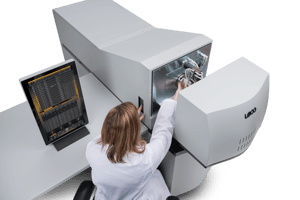Our innovative analytical instrumentation provides users with solutions for a wide range of applications. We want to help your lab succeed, which is why we share examples of the processes, methods of analysis, and results our instruments can obtain in the form of application notes. We want our current and potential customers to feel at ease with our instrumentation in the lab, and our application notes highlight the right instrument for each specific application.
 Our glow discharge atomic emission spectrometer, the GDS900, is a valuable resource for any laboratory needing precise and productive elemental determination. Its state-of-the-art design brings improved performance, stability, accuracy, and precision to your analysis. Our innovative Cornerstone® brand software and a touch-screen interface provides increased usability, simplified reporting, and streamlined analysis times.
Our glow discharge atomic emission spectrometer, the GDS900, is a valuable resource for any laboratory needing precise and productive elemental determination. Its state-of-the-art design brings improved performance, stability, accuracy, and precision to your analysis. Our innovative Cornerstone® brand software and a touch-screen interface provides increased usability, simplified reporting, and streamlined analysis times.
We’ve recently released a number of new application notes that highlight the benefits of the GDS900. These app notes detail the sample preparation, accessories, calibration parameters, analysis times, and typical results for the application of focus. Check out our latest below.
Bulk Analysis of Copper Alloys
Copper alloys are widely used due to their excellent electrical and thermal conductivity, corrosion resistance, ease of fabrication, and good strength. Chemical composition can be used as a basis for classifying copper alloys. The copper alloy producer must control the alloying composition of the heat to be sure it meets specification, and thereby have the desired properties of the target grade. Manufacturers that use copper alloys in their products should also verify the material before it is used in the final product. Copper alloys have a wide color range from red to yellow to silver, but completely different alloys can have a similar color. If the copper material is out of specification, then it will not hold up under the specific environment that it was intended for, and premature failure of the product could result.
Bulk Analysis of Cast and Wrought Aluminum Alloys
Aluminum alloys have a number of advantages as a structural metal—a high strength-to-weight ratio that can exceed that of structural steel, high corrosion resistance, good thermal and electrical conductivity, and desirable mechanical properties. Aluminum alloys can be divided into two major groups: casting alloys and wrought alloys. Wrought products include plate, foil, and extrusions. Casting alloys often include high levels of silicon which contributes to good casting characteristics. Aluminum alloys are particularly important in aerospace manufacturing due to their light weight.
Analysis of Low Alloy, Cr-Mo, Free Machining, and Austenitic High Mn Steels
With the existence of thousands of steel alloys, proper identification and classification is a critical business practice that is required to meet industry and customer requirements. One of the most effective means of classifying steels is by chemical composition. Mechanical properties such as hardness and strength are not absolute techniques for identification of steels. Glow discharge atomic emission spectrometry (GDS) is a chemical analysis technique that is well suited for routine determination in a wide variety of materials including steels.
Analysis of Stainless Steels (Corrosion and Heat-Resistant Steels)
Stainless steels comprise a large group of ferrous-based alloys offering a wide range of corrosion- and heat-resistant properties. This wide range of properties makes stainless steels very versatile. Each grade of stainless steel has a known set of physical characteristics that are directly related to the levels of alloying constituents present in the material. The two defining alloying elements are Cr and Ni, but components such as C, Mn, Mo, and Cu are also relevant. Chemical composition can be used as a basis for classifying stainless steels. The stainless steel producer must control alloying composition of the heat to be sure it meets specification, and thereby have the desired corrosion- and heat-resistant properties of the target grade.





